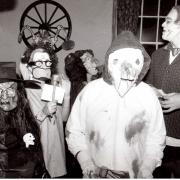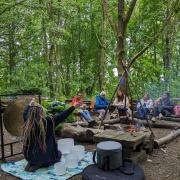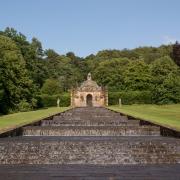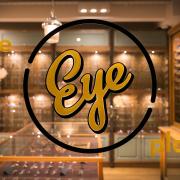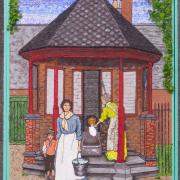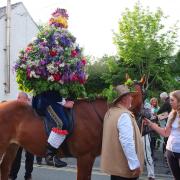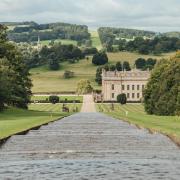Janine Sterland meets the curator of Chatsworth’s ongoing fashion exhibition and discovers how its collections are inspiring contemporary design while simultaneously securing a legacy through conservation
Housing an extensive collection of 18th century cotton chintz, sentimental family pieces, household livery, and bespoke garments crafted by renowned fashion houses, Chatsworth’s historic textile and clothing collections stands proudly within the world of contemporary design.
And over recent months, the public have been welcomed to the estate to take in an exhibition that is as thought provoking as it is inspiring, marrying invaluable historic pieces with modern-day innovative design.
‘The cloth collection covers a wide range of types,’ reveals Susie Stokoe, textiles and seasonal programme curator at Chatsworth.

Chatsworth’s reputation in this regard is not lost on one of Britain’s leading, multi-award-winning fashion designers, Erdem Moralıoğlu MBE.
Showcasing the celebrated Spring/Summer 2024 collection of the renowned fashion designer, Susie describes how Chatsworth’s fashion, textiles and wider decorative arts collections has inspired Erdem’s work.
These have manifested themselves through his reinterpretation of historic house fabrics, surface patterns and, notably, the style and fashion of Duchess Deborah’s clothing and jewellery collections.
‘Erdem was particularly inspired by the chintz collection,’ continues Susie. ‘As well as Chatsworth’s decorative arts, paintings and of course Duchess Deborah’s unique sense of style.’

‘Fabric is highly sensitive to environmental conditions such as light, which will fade and degrade it, or humidity, which will rot fabric.’ Susie explains.
‘So it’s always wonderful to have fabric of age which can be used to inspire or learn from. In addition, our textile collection, following an extensive programme of documentation, is now recorded on a database, which makes it far more accessible.’
As part of an ambitious programme, Susie describes the meticulous categorisation and transformation of Chatsworth’s fashion and textiles collections, from an unmethodical state into a highly detailed and organised catalogue.

‘It wasn’t until we had completed the masterplan at Chatsworth that the team were able to start the process of cataloguing and re-packing the collection.’
Following the enormous task of documenting, packing and recording its collections by dedicated team members, including Olivia and Amy, Susie explains that fabrics were uncovered and documented with the potential for design inspiration – proven most recently by Erdem.
Now, following the success of the project and the careful preservation of its collections, Susie reveals the context of Chatsworth’s collaboration and how a journey of research, inspiration and design has led to this extraordinary and innovative house exhibition.

The bulk of the textile collection, including some clothing, was stored in large cupboards and wardrobes, many of which ran along corridors.
A large proportion of the fabric remnants were wrapped in brown paper and tied with string before being put in the cupboards.
This was wonderful as it kept them dry and safe whilst awaiting rediscovery and documentation. A lot of the historic clothing was stored in large metal trunks, which again thankfully kept them pest (such as moth) free.
How did Chatsworth support Erdem at the start of his design research into the Chatsworth archives and the style of Duchess Deborah and when did you begin this collaboration?
Erdem first came to Chatsworth when he was researching Adele Astaire, who was married to Charles Cavendish.
The collaboration for his Spring/Summer 2024 collection started back in 2022. We introduced Erdem to our chintz collection and this formed a key part of his inspiration.
He also spent time with the archives team and curators of decorative arts and paintings. In addition, there are photographs which influenced his work, such as an iconic image of Duchess Deborah in a pale pink two piece suit feeding chickens, which inspired Erdem’s tweed suit with a frayed hem as if pecked by chickens.
Erdem has celebrated Chatsworth’s historic fashion collections as well as Duchess Deborah’s unique sense of style. Did the Duchess also wear some of the historic pieces from Chatsworth’s family archives?
Duchess Deborah’s style was very eclectic and she famously wore a dress made by the House of Worth to her 80th birthday party.
The dress was designed by Worth for Louise, Duchess of Devonshire, to wear at the Devonshire House Ball in 1897.
This dress is now one of the most prized objects in the textile collection, in fact it recently went on loan to the Ashmolean Museum in Oxford.

The guest apartments have been closed for a couple of years in order to conserve the hand painted Chinese wallpapers, which date from the 1790s.
The rooms were decorated by the Sixth Duke and house two beds that are draped in original chintz. Both beds have also been fully conserved by the in-house textile team, supported by the Trust.
This exhibition seemed like a perfect opportunity to relaunch these rooms onto the public route, whilst the floral papers also work wonderfully with the pieces from Erdem’s collection and the historic chintz included in the exhibition that helped to inspire his work.
How have you used sound and original house fabrics throughout the exhibition to make it an immersive and authentic experience?
We’ve used the original soundtrack of Erdem’s catwalk show at the British Museum alongside other recordings, such as the sound of insects recorded in the parkland which we have used alongside Duchess Deborah’s bug jewellery.
We have also incorporated sounds from a workroom to capture the atmosphere of an atelier, as well as recordings of both Duchess Deborah and Erdem to make them more present in the space.
This also means each room has a distinctive feel which is connected to the pieces on display, whilst the fabric drapes in the exhibition are a mixture of historic and the modern interpretations created by Erdem.
Why did you feel it was important to include aspects of the design development process in featuring a recreation of a design studio environment and what do you hope visitors will glean from this exhibition?
We ultimately wanted a narrative of muse, process and collection, whilst I also believe it’s important to understand the in depth and complex processes of creating a fashion collection.
I wanted the exhibition to not be just about a finished dress, but to include the work of the Trust in caring for the collections that in turn will continue to inspire creativity and design in the contemporary world.
Discover Imaginary Conversations at Chatsworth runs until October 20.






